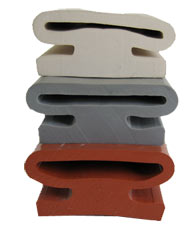Technical Help
If you need any help in choosing an inflatable seal for your application, you can send us a description or image of your application, and we can propose a solution for you.
Inflatable Seal Properties & Function
The most effective method for sealing between various surfaces which move in relation to one another is the inflatable seal. An inflatable seal is an elastomeric extrusion or molded tube or bladder that will expand or retract when a medium such as air or water is used to inflate the seal. An inflatable seal is designed to expand at a specific point to form a tight uniform seal between two surfaces.
Inflatable Seal Operation
Inflatable seals are designed to be operated with or without a groove. When air or water is introduced to inflate the seal, it will expand, striking its intended surface creating a positive seal. When the pressure inside the seal is released, it will retract to its original shape allowing for the two surfaces to move freely in relation to each other.
Inflating an Inflatable Seal
Most inflatable seals are inflated using regulated air through a valve installed on to the seal. Regulated air is required for all inflatable seals to prevent damage to the seal so that it does not over-expand during operation and rupture. Different profiles and fabric reinforcement will change the requirements and ability of the inflatable seal to handle various pressures. Several different types of fittings may be attached to the seal to accommodate the various methods of inflation.
The benefits of an Inflatable Seal
The inflatable seal is the most effective method to seal between surfaces that move in relation to one another over other sealing methods:
- It provides a leak-proof closure, yet allows clearance when needed.
- It simplifies the design of the structure and hardware.
- It minimizes the need for close machining and/or fabricating tolerances.
- It is not subject to compression set which negates effectiveness of other seals.
Inflatable Seal Geometry
Inflatable seals can be installed in different planes; radially in, radially out, axially and any combination thereof. They will conform to many different contours. They are made in strips with closed ends or in continuous loops. The bend radii will vary from seal to seal and if a very sharp or mitered corner is necessary, the seal can be molded to the exact configuration.
There are several factors involved in selecting the right rubber or plastic compound. For our inflatable seals we have made an Inflatable Seal Data Sheet to help you submit an application. Because we’re always updating our information to stay current, you can download a technical spec sheet for rubber compounds. Technical factors include:
- Chemical Resistance
- Durometer / Shore (Hardness)
- Tear Strengths
- Bend Radii without compromising sealing ability
- Compression rates
- UV protection and resistance
If you have any other technical questions, a DRI representative is available to help. Contact us.

